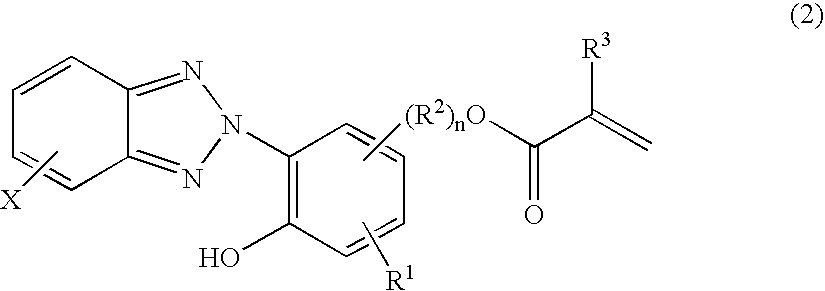Primer composition, coating method, and coated article
a technology of primer and coating, applied in the direction of synthetic resin layered products, coatings, transportation and packaging, etc., can solve the problems of adversely affecting the surface properties of polycarbonate resins, and affecting the adhesion of the primer layer to the substrate or the overlying protective coating of colloidal silica, etc., to achieve the effect of improving mar and weather resistan
- Summary
- Abstract
- Description
- Claims
- Application Information
AI Technical Summary
Benefits of technology
Problems solved by technology
Method used
Image
Examples
synthesis example 1
[0112]A 2-liter flask equipped with a stirrer, condenser and thermometer was charged with 152.3 g of diacetone alcohol as the solvent and heated at 80° C. in a nitrogen stream. To the flask were sequentially admitted a 240 g portion of a monomer mixture which had been previously prepared from 67.5 g of 2-[2′-hydroxyγ-5′-(2-methacryloxyethyl)phenyl]-2H-benzotriazole (RUVA-93 by Otsuka Chemical Co., Ltd.), 90 g of γ-methacryloxypropyltrimethoxysilane, 270 g of methyl methacrylate, 22.5 g of glycidyl methacrylate, and 350 g of diacetone alcohol, and a 54 g portion of a polymerization initiator solution which had been previously prepared by dissolving 2.3 g of 2,2′-azobis(2-methylbutyronitrile) in 177.7 g of diacetone alcohol. Reaction was effected at 80° C. for 30 minutes, after which the remainder of the monomer mixture and the remainder of the polymerization initiator solution were simultaneously added dropwise at 80–90° C. over 1.5 hours. The reaction solution was stirred at 80–90° ...
synthesis examples 2 to 9
[0114]Vinyl copolymer solutions, designated Pol-A2 to A9, were prepared as in Synthesis Example 1 using the monomers in the amounts as reported in Table 1. Their properties are also shown in Table 1.
[0115]
TABLE 1Synthesis Example123456789a-1RUVA-167.53667.590922567.567.5(15%)(8%)(15%)(20%)(2%)(50%)(15%)(15%)RUVA-267.5(15%)a-2MPTMS909180904527090(20%)(2%)(40%)(20%)(10%)(60%)(20%)APTMS90(20%)a-3MMA270297283.5135328.5180270112.5270(60%)(66%)(63%)(30%)(73%)(40%)(60%)(25%)(60%)GMA22.522.54522.567.522.5(5%)(5%)(10%)(5%)(15%)(5%)EA22.522.522.5(5%)(5%)(5%)ViAc22.522.522.5(5%)(5%)(5%)MHALS4.5(1%)Total monomer450450450450450450450450450charge(100%)(100%)(100%)(100%)(100%)(100%)(100%)(100%)(100%)CopolymerPol-A1Pol-A2Pol-A3Pol-A4Pol-A5Pol-A6Pol-A7Pol-A8Pol-A9Viscosity (cp)13,3005,02010,1002,02017,3003,35011,8002,8508,960Nonvolatile44.543.842.944.244.843.043.744.343.5content (%)Mw81,00070,60095,30080,10069,40050,800100,60082,90069,900Note:a-1: benzotriazole-derived UV-absorbing vinyl monomerRUVA...
synthesis example 10
[0116]A 2-liter flask equipped with a stirrer, condenser and thermometer was charged with 222 g of N-(2-aminoethyl)-3-aminopropyltrimethoxysilane and 242 g of hexamethyldisilazane as the silylating agent and heated at 120° C. in a nitrogen stream. Then 496 g of γ-glycidoxypropylmethyldiethoxysilane was added dropwise to the solution, which was heated and stirred at 120° C. for 5 hours for reaction. A low-boiling fraction was removed at 100° C. under reduced pressure, obtaining 862 g of a viscous product having a viscosity of 1,387 cs, a refractive index of 1.4618 and a specific gravity of 1.048.
[0117]Next, a 2-liter flask equipped with a stirrer, condenser and thermometer was charged with 862 g of the reaction product and 862 g of toluene. Under a nitrogen stream, 141 g of acetic anhydride was added dropwise to the solution at room temperature. The solution was heated and stirred at 110° C. for 2 hours for reaction. Then 141 g of methanol was added dropwise to the solution at 50° C....
PUM
| Property | Measurement | Unit |
|---|---|---|
| glass transition temperature | aaaaa | aaaaa |
| Tg | aaaaa | aaaaa |
| temperature | aaaaa | aaaaa |
Abstract
Description
Claims
Application Information
 Login to View More
Login to View More - R&D
- Intellectual Property
- Life Sciences
- Materials
- Tech Scout
- Unparalleled Data Quality
- Higher Quality Content
- 60% Fewer Hallucinations
Browse by: Latest US Patents, China's latest patents, Technical Efficacy Thesaurus, Application Domain, Technology Topic, Popular Technical Reports.
© 2025 PatSnap. All rights reserved.Legal|Privacy policy|Modern Slavery Act Transparency Statement|Sitemap|About US| Contact US: help@patsnap.com


